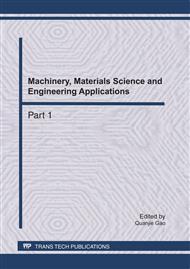p.66
p.72
p.77
p.83
p.88
p.96
p.101
p.106
p.114
Simulation of Compound Bulging Process for T-Branch Tubes Using Rubber Medium
Abstract:
To determine the optimum process parameters and loading paths for T-branch tube compound bulging using rubber medium, a finite element model was established at the software platform of ANSYS/LS-DYNA. Tubular blank parameters were optimized while the affections of blank parameters and frictions in bulging process were analyzed, during which Taguchi method, sensitivity analysis and normalization method were adopted and an evaluation function is inducted. The Taguchi method was used to establish a design of simulation schemes, and numerical simulations were carried; a sensitivity analysis was carried out with analysis of variances to seek the significance of parameters; the evaluation function was inducted to synthetically evaluate the affections of the thickness variation and the branch height and normalization method are applied to ensure equality of two sets of data in the evaluation function. Then the execution method and loading path of counter force for compound bulging process were designed and an ideal T-branch tube was gained at last.
Info:
Periodical:
Pages:
88-95
Citation:
Online since:
April 2011
Authors:
Price:
Сopyright:
© 2011 Trans Tech Publications Ltd. All Rights Reserved
Share:
Citation:


